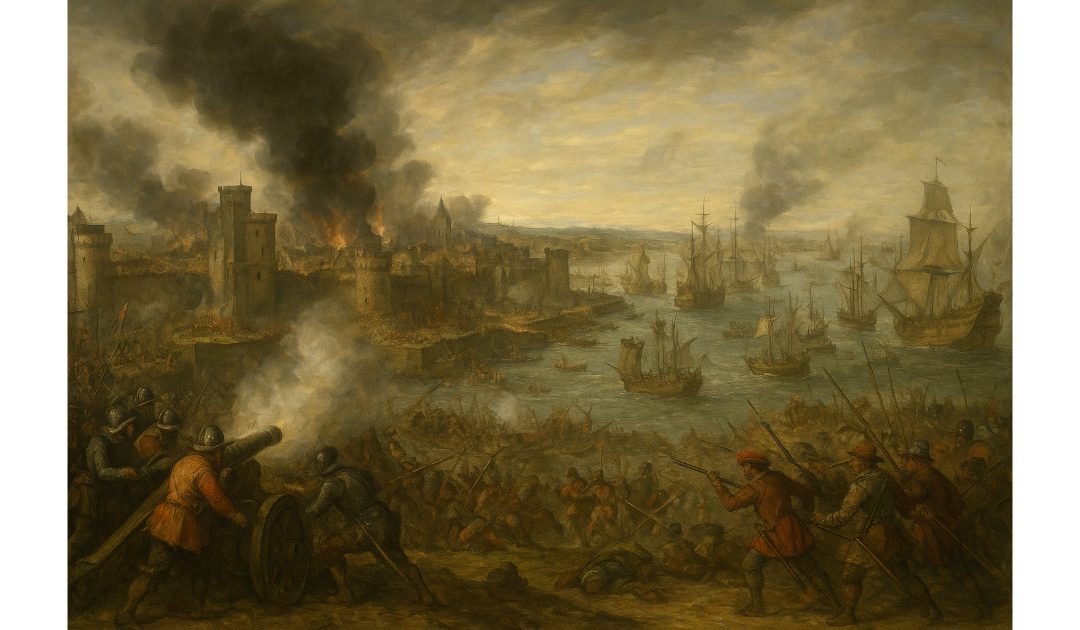The siege of La Rochelle ended on the 28th of October, 1628, after fourteen months. It falls beyond the span of my work in progress, The Favourite Murder, the fifth book in the Sir Anthony Standen Adventures. However it does introduce Cardinal Richelieu, a key figure in the siege. The Siege of La Rochelle (1627–1628) was a pivotal conflict during the French Wars of Religion, illustrating the dramatic struggle between the Catholic monarchy and the Huguenot Protestant stronghold of La Rochelle, one of France’s most fortified and prosperous port cities.
Background:
Following the Edict of Nantes in 1598, which granted a degree of religious freedom to Huguenots, tensions persisted between the Protestant minority and the Catholic majority. La Rochelle emerged as a dominant Huguenot centre, thriving economically due to its maritime prowess and strategic position on France’s western Atlantic coast. Its autonomy and fortified status were a constant thorn in the side of the French Crown, which sought to consolidate power under Louis XIII and his influential chief minister, Cardinal Richelieu.
Prelude to the Siege:
By the 1620s, Richelieu aimed to suppress Huguenot resistance and dismantle their fortified enclaves. The immediate cause of the siege was the failed expedition led by the Duke of Buckingham from England, intending to support the Huguenots. Buckingham’s ill-fated assault on Île de Ré in 1627 faltered, leaving La Rochelle isolated. Richelieu capitalised on this vulnerability, initiating a comprehensive siege to crush the city’s defiance.
The Siege Begins:
In September 1627, Richelieu orchestrated a formidable siege, employing approximately 20,000 royal troops. Recognising the city’s strong maritime lifeline, he devised an unprecedented strategy to block La Rochelle’s sea access. A massive seawall, stretching over 1,400 metres across the harbour entrance, was constructed under arduous conditions. This engineering feat, bolstered by sunken ships and fortified positions, effectively strangled the city’s supply routes.
Within La Rochelle, the defenders, numbering around 15,000 civilians and militia, were resolute under the leadership of Mayor Jean Guiton. The city’s formidable walls and determination made direct assaults costly, compelling Richelieu to rely on attrition rather than brute force.
Conditions During the Siege:
As months dragged on, La Rochelle descended into desperation. Starvation and disease ravaged the population. Accounts describe harrowing scenes of famine: people resorted to eating leather, roots, and even worse. Despite these hardships, morale remained surprisingly resilient, driven by religious fervour and the hope of external relief.
Meanwhile, England launched another attempt to break the siege, but the relief fleet, poorly coordinated and inadequately supplied, failed to breach Richelieu’s formidable blockade. This dashed the last hopes of salvation for La Rochelle’s inhabitants.
Richelieu’s Leadership:
Richelieu’s personal involvement was instrumental. Unlike other commanders who might have delegated from afar, he remained at the siege lines, overseeing military operations, engineering projects, and even diplomatic manoeuvres. His presence was both symbolic and practical, reinforcing royal authority and ensuring the siege’s relentless progression.
The Fall of La Rochelle:
By October 1628, after over a year under siege, La Rochelle’s situation was untenable. Its population had dwindled from 28,000 to fewer than 5,000 due to starvation and disease. Recognising the futility of further resistance, the city capitulated on the 28th of October 1628.
Despite the brutal siege, Richelieu displayed a measure of clemency. While the city’s political and military autonomy was crushed, religious practices were not entirely eradicated. The fall of La Rochelle marked the effective end of Huguenot political power in France, though religious tensions simmered for decades, culminating in the revocation of the Edict of Nantes in 1685.
Aftermath and Legacy:
The siege had lasting consequences. Politically, it cemented the absolute authority of the French monarchy. Richelieu’s strategy showcased the centralisation of power under Louis XIII, diminishing the feudal autonomy that had characterised earlier France.
Militarily, the siege demonstrated the evolution of siege warfare, combining traditional methods with innovative engineering. The construction of the seawall was a landmark in military engineering, influencing future military strategies in Europe.
Culturally and socially, the siege left scars on La Rochelle. The city never fully regained its former prominence, and the Huguenot community faced increasing marginalisation. Many Protestants emigrated in subsequent decades, contributing to the Huguenot diaspora across Europe and the Americas.
In historical memory, the Siege of La Rochelle is emblematic of the clash between religious conviction and state power. It reflects the broader narrative of the 17th century, where emerging nation-states sought to impose uniformity and central control, often at the expense of regional identities and religious freedoms.
Today, La Rochelle’s preserved fortifications and monuments stand as silent witnesses to this dramatic chapter in French history, attracting historians and visitors intrigued by its resilient spirit and tumultuous past.

